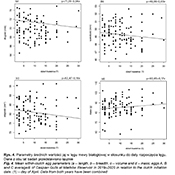 Larus cachinnans in Poland
Larus cachinnans in Poland
(last update: August 01, 2021)
Marcin Przymencki
Klaudia Litwiniak
Mars Muusse
 Reproductive ecology and abundance of the Caspian Gull Larus cachinnans
Reproductive ecology and abundance of the Caspian Gull Larus cachinnans
at Mietków Reservoir in 2019–2020 (PDF).
Marcin Przymencki, Klaudia Litwiniak, Magdalena Zagalska-Neubauer, Grzegorz Neubauer
Ornis Polonica 2021, 62: 169–188
Abstract:
The Caspian Gull Larus cachinnans is a large gull species, which expands its breeding area in Europe and increases in numbers. The first Polish breeding records of the species come from the early 1980s, and its current population is estimated at 3000–3500 breeding pairs. Despite its widespread occurrence on the continent, the species reproductive ecology has not been well described, and many aspects of its biology still remain unknown.
In 2019–2020 we studied the breeding ecology of the Caspian Gull at Mietków Reservoir (Lower Silesia). We recorded a minimum of 260 breeding pairs in 2019 and at least 190 pairs in 2020. Birds started nesting in the first decade of April.
Dimensions of nests (medians) were as follows: outer diameter – 47 cm, inner diameter – 23 cm, height – 7 cm, depth – 7 cm. Mean volume of the first eggs, called A-eggs was 84.4 cm3 , B-eggs – 82.3 cm3 and C-eggs – 76.6 cm3 . Length, width and volume of eggs tended to decrease with the increasing laying date. The full clutch volume was 241.2 cm3 and 245.2 cm3 in 2019 and 2020, respectively. Relative volumes of C-egg in clutches constituted 0.91 and 0.93 of the mean volume of A- and B-eggs in the two study years, respectively.
In both study years 15.5–15.9% of eggs from 25.6–32.1% of clutches were lost, and 2.43–2.48 chicks per a breeding pair hatched. In 2019 the daily chick survival rate was estimated at ~0.95, while the probability of the nestling survival until the age of 22 days after hatching was ~0.36 (before the flooding of the colony due to heavy rainfall). The second (after 17 May) flooding of the colony resulted in the death of more than 90% of nestlings. In 2020 the survival rate of the young was lower and more variable than the year before, and the probability of survival until the 17th day of life was only ~0.23.
We compare our data with the results obtained in other colonies in Poland and Ukraine.

Mietków Reservoir & Chwałów: 50°57’04.1″N 16°36’06.5″E.
Annual numbers for Mietków Reservoir:
| year | pairs | ringed |
| 2021 | -- | -- |
| 2020 | 190 | 233 |
| 2019 | 260 | 163 |
| 2018 | 230 | 290 |
| 2017 | 250 | 245 |
| 2016 | + | 17 |
 Location:
Location:Mietków Reservoir & Chwałów in SW Poland.
Active map with colonies.
 Caspian Gull cachinnans PLG DN 25430 1CY, August - October 2011, Deponie Pohlsche Heide - Minden, Germany. Picture: Armin Deutsch.
Caspian Gull cachinnans PLG DN 25430 1CY, August - October 2011, Deponie Pohlsche Heide - Minden, Germany. Picture: Armin Deutsch. Caspian Gull type Larus cachinnans sensu lato PLG DN 25436 2CY-3CY, July - August 2012 & February 2013, Deponie Pohlsche Heide - Minden, Germany. Picture: Armin Deutsch.
Caspian Gull type Larus cachinnans sensu lato PLG DN 25436 2CY-3CY, July - August 2012 & February 2013, Deponie Pohlsche Heide - Minden, Germany. Picture: Armin Deutsch.Possibly with Yellow-legged Gull influences.
 Caspian Gull cachinnans PLG DN 25463 2CY, March 22 2012, Deponie Pohlsche Heide - Minden, Germany. Picture: Armin Deutsch.
Caspian Gull cachinnans PLG DN 25463 2CY, March 22 2012, Deponie Pohlsche Heide - Minden, Germany. Picture: Armin Deutsch. Caspian Gull cachinnans 5P45 5CY, January 29 - February 03 2009, CET Champteussé-sur-Baconne, France. Picture: Alain Fossé.
Caspian Gull cachinnans 5P45 5CY, January 29 - February 03 2009, CET Champteussé-sur-Baconne, France. Picture: Alain Fossé. Caspian Gull cachinnans 5P56 adult, August 13 2007 & August 11 2009, Mur de Lixhe, Belgium. Picture: Charly Farinelle.
Caspian Gull cachinnans 5P56 adult, August 13 2007 & August 11 2009, Mur de Lixhe, Belgium. Picture: Charly Farinelle.  Caspian Gull cachinnans 062P 4CY, February 10 2009, Bishop's Cleeve landfill site, UK. Picture: John Sanders.
Caspian Gull cachinnans 062P 4CY, February 10 2009, Bishop's Cleeve landfill site, UK. Picture: John Sanders. Caspian Gull cachinnans 689P 3CY, October 10 2018, Katwijk, the Netherlands. Picture: Mars Muusse.
Caspian Gull cachinnans 689P 3CY, October 10 2018, Katwijk, the Netherlands. Picture: Mars Muusse. Caspian Gull cachinnans P:C00 4CY, September & October 2020, IJmuiden & Langevelderslag strand, the Netherlands. Picture: Mars Muusse.
Caspian Gull cachinnans P:C00 4CY, September & October 2020, IJmuiden & Langevelderslag strand, the Netherlands. Picture: Mars Muusse. Caspian Gull cachinnans P:C96 2CY, September 25 2018, Westkapelle, the Netherlands. Picture: Mars Muusse.
Caspian Gull cachinnans P:C96 2CY, September 25 2018, Westkapelle, the Netherlands. Picture: Mars Muusse. Caspian Gull cachinnans P:D79 2CY, October 10 2018, Katwijk, the Netherlands. Picture: Mars Muusse.
Caspian Gull cachinnans P:D79 2CY, October 10 2018, Katwijk, the Netherlands. Picture: Mars Muusse. Caspian Gull cachinnans P:S66 1CY, October 22 2018, Katwijk, the Netherlands. Picture: Mars Muusse.
Caspian Gull cachinnans P:S66 1CY, October 22 2018, Katwijk, the Netherlands. Picture: Mars Muusse.
Could this be a hybrid?
 Caspian Gull cachinnans P:T16 3CY, October 02 2020, IJmuiden beach, the Netherlands. Picture: Mars Muusse.
Caspian Gull cachinnans P:T16 3CY, October 02 2020, IJmuiden beach, the Netherlands. Picture: Mars Muusse.
 Mediterranean Gull (Ichthyaetus melanocephalus) PEE5 adult, March 09 2020, Boulogne-sur-Mer, NW France. Picture: Mars Muusse.
Mediterranean Gull (Ichthyaetus melanocephalus) PEE5 adult, March 09 2020, Boulogne-sur-Mer, NW France. Picture: Mars Muusse.